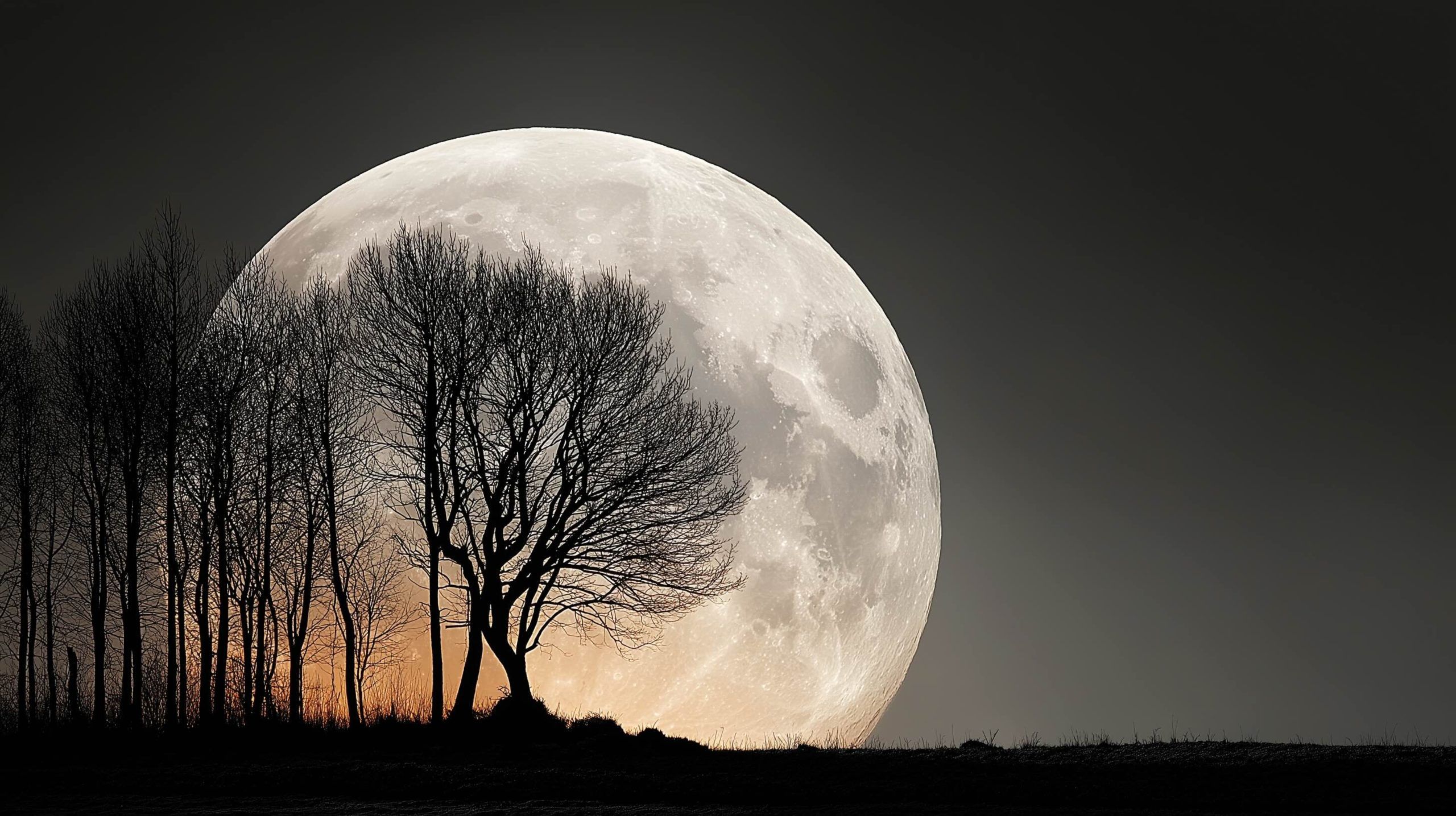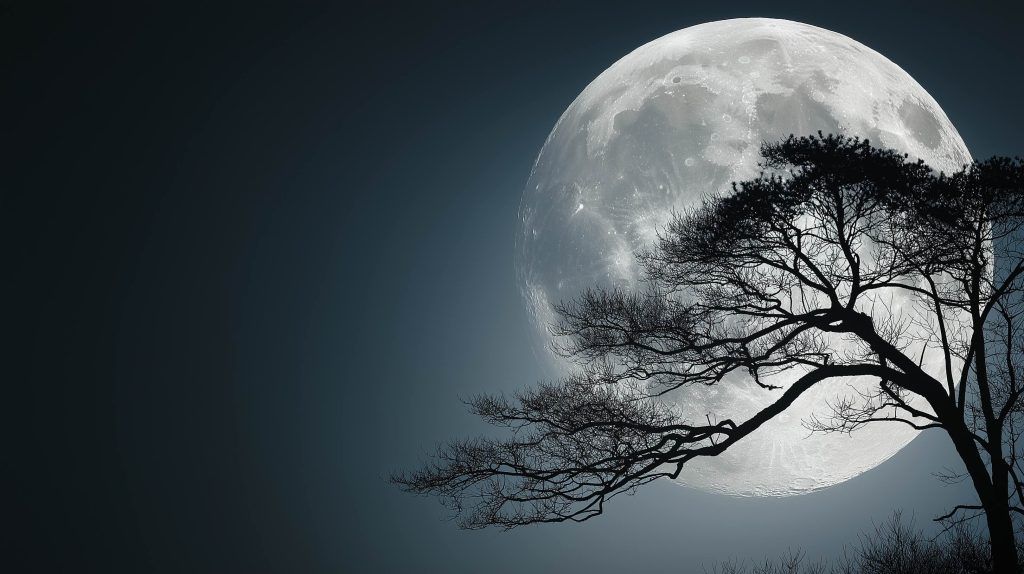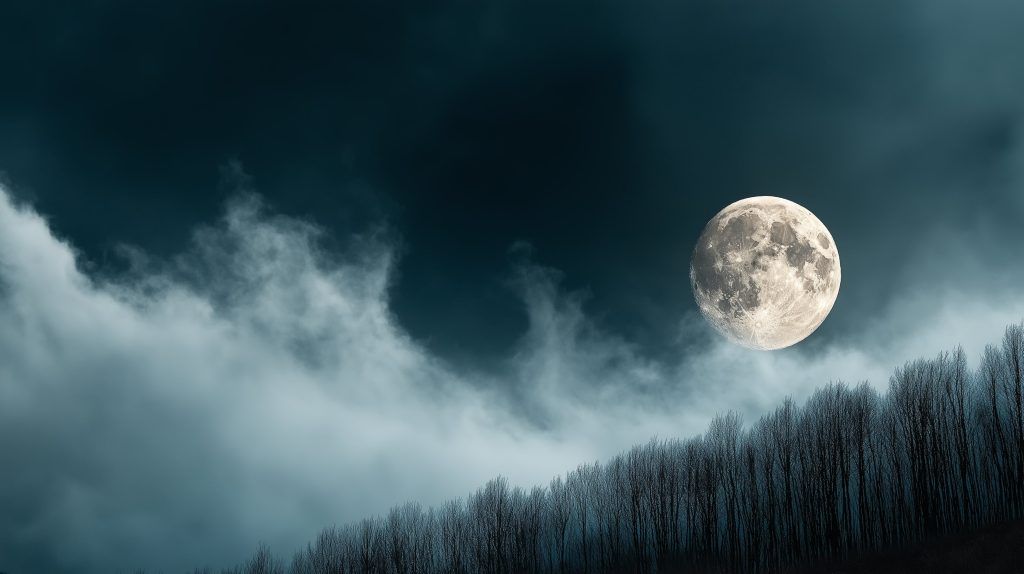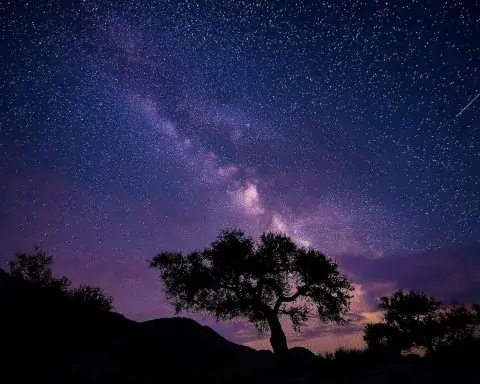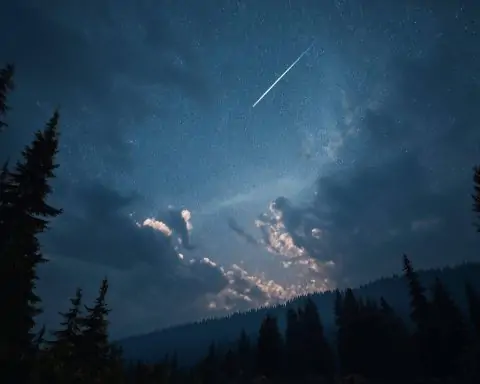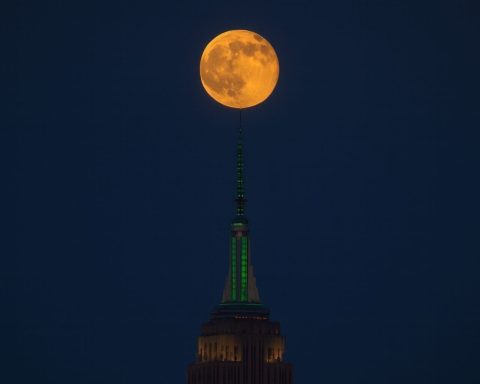- The Beaver Moon occurs on November 5, 2025, with peak illumination at 13:19 GMT (8:19 a.m. EST).
- At peak, the Moon will be about 356,980 km (221,818 miles) from Earth, roughly 7.9% closer and about 16% brighter than an average full Moon.
- It’s a supermoon—the biggest and brightest full Moon of 2025, and the closest full Moon since 2019.
- The full Moon is traditionally Beaver Moon, but in 2025 it can also be regarded as the Hunter’s Moon because the Harvest Moon fell on October 6; this overlap last occurred in 2020 and won’t recur until 2028.
- The Moon sits in Taurus with the Sun in Scorpio at 13° Taurus.
- On the night of November 6, the nearly full Moon passes within one degree of the Pleiades star cluster in Taurus.
- On November 10, the Moon will be about 4° from bright Jupiter in the late evening.
- Uranus reaches opposition on November 21, 2025, making the ice giant brightest for the year and visible with binoculars or a telescope.
- The Southern Taurids peak around November 4–5, the Northern Taurids a week later, and the Leonids around November 17–18.
- There will be no lunar eclipse with this Moon; 2025’s eclipses occurred in March and September.
When Is November 2025’s Full Moon and Why Is It Special?
Mark your calendars: the full moon of November 2025 occurs on Wednesday, November 5, 2025, reaching peak illumination at 13:19 GMT (8:19 a.m. EST) [1] [2]. This isn’t just any full moon – it’s a supermoon, and in fact the biggest and brightest full Moon of 2025. At that moment, the Moon will be only about 356,980 km (221,818 miles) from Earth, roughly 7.9% closer (and 16% brighter) than an average full moon [3] [4]. That earns it the title of “Super Beaver Moon”, as it appears slightly larger and more luminous than usual. To the casual eye the difference is subtle – most people can’t tell a supermoon from a normal full moon by size alone [5] – but the extra brightness (up to ~15% more than a typical full moon) can be noticeable on a clear night [6] [7]. Either way, it’s a fun chance to gaze up and know you’re seeing the closest full moon of the year [8].
Astronomically, a full moon occurs when the Moon lies exactly opposite the Sun with Earth in between, so the lunar disk is fully illuminated [9]. This happens at a precise instant (in this case mid-day for UTC), but the Moon will appear strikingly full on the nights of November 4 and 5 for observers around the world. In some places the Moon may be below the horizon at the exact moment of fullness [10], but don’t worry – to our eyes it will look fully illuminated throughout the night. As darkness falls on November 5, the Moon will rise in the east around sunset and shine brilliantly all night (weather permitting). It will be positioned in the stars of the constellation Aries on the sky’s dome [11], hovering not far from the brilliant Pleiades star cluster in Taurus. In fact, on the night of November 6 the nearly full Moon passes within a degree of the Pleiades [12]. The Moon’s glare may wash out the delicate “Seven Sisters,” but with binoculars you might still glimpse the cluster near the glowing lunar disk [13].
Notably, this November full moon will not bring a lunar eclipse in 2025 – it’s simply a bright full moon (the year’s lunar eclipses occurred in March and September). However, skywatchers can enjoy other celestial sights. The Southern Taurid meteor shower peaks around November 4–5, but with the Moon ~99% full that night, only the very brightest meteors (perhaps the occasional fireball) will be visible through the moonlight [14]. “Their November peak falls on the Full Moon, so it’s better to postpone observing for a few days until the moonlight is less intrusive,” one astronomy guide advises [15]. After the full moon glare subsides, the Northern Taurids a week later and the Leonid meteor shower around November 17–18 will have darker skies (the Leonids peak just before the new moon, offering up to ~20 meteors per hour under ideal conditions) [16]. In the days following November 5, the waning gibbous Moon will also pass near some planets: for example, on November 10 the Moon swings about 4° from bright Jupiter in the late evening [17], making for a pretty pairing in the night sky. And later in the month, stargazers can look for Uranus at opposition on November 21, 2025, when that distant ice giant shines at its brightest for the year (though you’ll need binoculars or a telescope to spot its tiny blue-green disk) [18]. All in all, November 5 will kick off an exciting month for night-sky fans with its headline act – a radiant supermoon – setting the stage.
“Beaver Moon” or “Hunter’s Moon”? Folklore of November’s Full Moon
The full moon of November is traditionally known in American folklore as the Beaver Moon. This evocative name is often said to originate from Native American and early Colonial era practices. Algonquin tribes and other Native peoples named this late-autumn moon for the busy beavers at work preparing for winter – building dams and lodges and caching food under the light of the full moon [19]. Another interpretation is that November was the time to set beaver traps before swamps froze, ensuring a supply of warm furs for the cold season [20] [21]. The name was later popularized by the Maine Farmer’s Almanac in the 1930s when it published “Indian” names for full moons [22]. As one NASA lunar expert noted, early English usage actually called the full moon after the Harvest Moon the “Hunter’s Moon,” but the Almanac’s adoption of Native American names led to calling November’s moon the Beaver Moon in most years [23]. Other traditional English names for this time include Frost Moon or Frosty Moon, and even Snow Moon by some (though “Snow Moon” is more commonly used for February’s moon) [24] [25]. All convey the oncoming winter chill.
Interestingly, 2025 is a special case: by one definition this full moon can also be considered the Hunter’s Moon. Typically, the “Hunter’s Moon” is the first full moon after the Harvest Moon (the full moon nearest the autumn equinox) [26]. In most years the Harvest Moon falls in September, making October’s moon the Hunter’s Moon. But in 2025, the Harvest Moon fell in early October (October 6), so the November 5 moon becomes the Hunter’s Moon for that year [27]. This is somewhat rare – “2025 is one of those rare years when the November Full Moon takes the title,” notes one astronomy source, pointing out that the last time this happened was five years prior and it won’t occur again until 2028 [28]. In a playful nod to this quirk, one skywatching newsletter teased: “Beavers, beware! The hunters have taken over the Supermoon. This year’s November Full Moon is called the Hunter’s Moon, instead of the usual Beaver Moon… sorry, beavers, better luck in 2026!” [29] [30]. So if you see the November 2025 full moon referred to as the Hunter’s Moon, don’t be confused – it’s the same moon, just an alternate name rooted in European tradition. Whether you prefer Beaver Moon or Hunter’s Moon, both names carry the atmosphere of late autumn: a time when hunters once tracked fattened game by moonlight after the harvest, and when beavers stockpile wood and retreat to their lodges for winter [31] [32].
Of course, many cultures have their own names for the moons. Other Native American tribes used names like Freezing Moon, Frost Moon, or Trading Moon for the November full moon [33] [34], reflecting the cold temperatures and final preparations for winter trade and survival. In some Celtic and Wiccan traditions, the November full moon is called the Mourning Moon or Dark Moon, being the last full moon before the winter solstice – a time for reflection and letting go of the year’s burdens [35]. According to folklore, this “Darkest Depths” moon signals a period of transition into the deepest part of the year’s darkness [36]. Meanwhile, traditional Chinese calendars dub the 11th lunar month’s full moon the White Moon [37], and neo-pagans sometimes use Snow Moon for November as well [38]. Even down in the Southern Hemisphere, November’s full moon takes on completely different meanings – since November there is late spring, names like Corn Moon, Milk Moon, Flower Moon, or Hare Moon are used in various traditions for the full moons around that time [39]. It’s a great reminder of how the significance of each full moon flips with the seasons depending on where you are on the globe.
No matter the name, people have long imbued this full moon with meaning. The Beaver Moon signifies that winter is on the horizon. It was a signal to settle in, finish the last of the harvest chores, and in ages past, ensure one’s home (and wardrobe) was ready for the freezing months ahead. Even today, the quaint full-moon names from folklore keep us connected to seasonal rhythms and the ingenuity of those who came before us. As the old saying goes, “Such is the power of folklore.” [40] [41] We still look up at the November moon and recall the beavers, the hunters, the frosts – a cultural echo across the centuries every time that brilliant orb lights up the late autumn sky.
Festivals and Traditions Under the November Full Moon
Around the world, the November full moon is linked to vibrant festivals and sacred traditions, many of them celebrations of light as the days grow darker. In the Indian subcontinent, the full moon of the Hindu month Kartik is celebrated as Kartik Purnima, a major Hindu, Sikh, and Jain holy day [42] [43]. In 2025, this falls on November 5, the same date as the Beaver Moon. Hindus observe this day with devotions and lamp-lighting ceremonies – in some regions it’s called Tripuri Purnima or Dev Deepawali, meaning “the Diwali of the gods,” when the heavens are believed to be illuminated in celebration [44] [45]. In cities like Varanasi, India, thousands of oil lamps (diyas) are lit on river ghats for Dev Deepawali, creating a breathtaking spectacle of light reflected in the Ganges. It is a day of offering prayers, taking holy baths in rivers, and honoring deities – according to legend, Lord Shiva defeated the demon Tripurasura on this full moon, and the gods rejoiced with their own festival of lights [46] [47]. The festival is also linked to Lord Vishnu and the goddess Tulsi in various traditions [48]. In Sikhism, this full moon is observed as Guru Nanak Gurpurab, the birth anniversary of Guru Nanak, founder of the Sikh faith. In 2025, Sikhs worldwide will celebrate Guru Nanak’s 556th birthday on November 5 with candlelight processions, hymn-singing, and free community meals (langar) in gurdwaras [49]. It’s one of the most important Sikh holidays, and gurdwaras (Sikh temples) are illuminated with strings of lights to honor the Guru’s enlightenment. Jains also mark Kartik Purnima with religious observances, as it is considered an auspicious day in Jain tradition.
Meanwhile, across Southeast Asia, November’s full moon heralds spectacles of water and light. In Thailand, the night of the 12th full moon of the year is celebrated as Loy Krathong, the famed Festival of Lights, which in 2025 falls on around November 5–6 [50] [51]. On this evening, Thais gather at rivers and lakes to launch krathong – small floating baskets holding candles, incense, and flowers – as offerings to the water goddess and to symbolically let go of misfortunes. Thousands of flickering candlelit rafts drift downstream, a magical sight under the full moon. In the northern Thai region (and parts of Laos and Myanmar), this coincides with Yi Peng, where countless glowing paper lanterns are released into the sky, lifting prayers and hopes heavenward. The result is a truly enchanted scene of a full moon shining above and lanterns rising like new stars. These traditions are so cherished that they’re observed in neighboring countries as well under different names. For example, Myanmar celebrates the Tazaungdaing Festival (Festival of Lights) on the full moon of Tazaungmon (the Burmese month coinciding with November) [52]. Cities like Yangon and Mandalay are lit up with lanterns and electric lights; a particularly spectacular event takes place in Taunggyi, Myanmar, where a hot-air balloon competition launches enormous firelit paper balloons into the night sky in the days around the full moon [53]. These balloons, some carrying dazzling fireworks, glow against the darkness – a tradition that has become world-famous. The Tazaungdaing full moon also marks the end of the monsoon season and is a time for giving alms and weaving special monk robes overnight in a merit-making marathon [54] [55]. In Cambodia, the November full moon marks the climax of Bon Om Touk, the Cambodian Water Festival. In 2025 the water festival spans November 4–6, with boat races and celebrations in Phnom Penh wrapping up by the full moon night [56] [57]. The full moon signifies the reversal of the Tonlé Sap River’s flow and is welcomed with ornate illuminated floats on the water and fireworks. Similarly, Sri Lanka observes the November full moon as Il (Ill) Poya, a day for Buddhist rituals and remembrance. All these festivals – from South Asia to Southeast Asia – are tied together by the full moon and often by the element of light overcoming darkness, whether through lamps on water or lanterns in the sky. In fact, the Burmese, Thai, Laotian, and Khmer celebrations are historically related, tracing back to ancient harvest and Buddhist traditions that spread across kingdoms [58] [59].
Even in the West, though we don’t have a November “full moon festival” per se, certain annual events sync up with the lunar cycle. For instance, the Thanksgiving holiday in the U.S. often falls in late November (though it’s set by the calendar, not the moon), and some have noticed that a bright Beaver Moon around that time adds to the cozy, reflective mood of the season. In Wiccan and neo-pagan communities, the Mourning Moon in November is sometimes observed with rituals of release and gratitude for the year’s lessons, aligning with the idea of clearing out the old as winter nears. And as mentioned, the Hindu/Sikh Kartik Purnima celebrations have also spread globally with the diaspora – one can find Dev Diwali lamp ceremonies on the banks of the Thames in London, or Gurpurab processions in Canada, all under the same luminous moon. All these cultural threads show how a single astronomical event – the full moon – can spark joyous human traditions across continents. On November 5, 2025, as the Super Beaver Moon rises, it will cast its silvery glow on everything from Indian temples and Thai waterways to Canadian gurdwaras and American backyards, uniting us in a moment of shared wonder and celebration.
Astrological Insights: A Full Moon in Taurus’s Light
Full moons have always carried deep symbolic weight in astrology, and the Beaver Moon of 2025 is no exception. In Western astrology, this moon occurs with the Sun in Scorpio and the Moon in the opposite sign of Taurus (13° Taurus, by one calculation [60]). Astrologers note that Taurus is an Earth sign associated with stability, security, money, and what we value, while Scorpio (where the Sun resides) governs transformation, secrets, and emotional intensity. Thus, this November 2025 full moon is seen as a cosmic tug-of-war between comfort and change – a time when we’re prompted to balance our need for material/emotional security (Taurus’s domain) against the pressure to evolve or release what no longer serves us (Scorpio’s influence). “From an astrological perspective, November’s Full Moon is about confronting uncomfortable changes and challenging your stability,” one astrologer explains, “as Taurus rules things like money, security, and values. So expect this full moon to reveal heavy themes related to relationships, romance, and self-worth” [61]. In other words, buried feelings or longstanding issues, especially around personal security or partnership dynamics, may come to the surface around this time. If something has been holding you back or making you feel stuck, the energy of this moon might illuminate it – possibly pushing you to make a decision (Taurus doesn’t like change, but Scorpio season can force necessary transformations).
Notably, some astrologers also tie this full moon to larger cycles. Late 2025 is coming off a series of eclipses and planetary retrogrades, so there’s a sense of closure and culmination in the air. In fact, Saturn, planet of discipline and karma, ends its retrograde period in November 2025 (Saturn turns direct on November 15, 2025, in Pisces). The Beaver Moon happens just before that shift, which astrologers interpret as adding a serious, grounding undertone. “The Beaver Moon on November 5 will coincide with the end of Saturn’s retrograde,” notes one astrology forecast, “The Full Moon in Taurus will encourage [people] to be calm and indulge in life’s finer pleasures, while Saturn ensures they do not shirk their responsibilities” [62]. In other words, there’s room for enjoyment and appreciating what we have (a very Taurean impulse to cozy up with good food, beauty, and comfort), but Saturn’s influence means any revelry comes with a reminder of duties and long-term goals. This could manifest as a reality check in the days following the full moon – perhaps an insight into how to better balance pleasure and productivity, or a nudge to firm up plans for financial and emotional security going forward.
Astrologically, full moons are often seen as a time of illumination and release – the peak of a cycle when things “come to light.” Since this one is a full Supermoon in Taurus, astrologers might say its effects on moods and tides (literal and metaphorical) are a bit amplified. Some might feel a surge of emotion or a strong urge to finalize something that’s been building since the new moon earlier in the month. The fact that it’s the 11th full moon of the year and one of the brightest could symbolically represent clarity: shining a light on issues of personal worth, possessions, and loyalty (Taurus themes) and how those intersect with deeper changes or power struggles (Scorpio themes) in our lives. One astrologer quipped that “the rising of the Beaver Moon signals the absence of heat and light, welcoming the arrival of the dark months”, encouraging us to identify what we need to do to prepare our inner selves [63]. It’s a time to let go of old baggage – “cleanse the energy that doesn’t care about our comfort and leave behind self-imposed limitations,” as another astrology commentary put it [64]. The idea is that by releasing something now (a bad habit, a toxic relationship pattern, a financial worry), we make space for a “new beginning” that will unfold in the next chapter. Indeed, many astrologers view the full moon as an auspicious moment for spiritual practice and manifestation. Ancient traditions considered the full moon a powerful time for meditation and setting intentions, and this one is no different [65]. The six months following (until the next Taurus full moon or eclipse) could be a window for growth based on what revelations occur now [66].
For those who follow zodiac horoscopes, the November 2025 full moon’s influence can vary by your sign. For example, it directly impacts Taurus and Scorpio individuals most strongly, since it’s in those signs – many Taurus folks might feel it in their relationships or see a personal project culminate, while Scorpios could experience shifts in partnerships or a personal breakthrough after confronting a fear [67] [68]. Other signs get unique takeaways: Geminis might find this lunation brings turning points in health or daily routine, Leos could see a flurry of social activity or networking opportunities, Aquarians might feel romance and creativity highlighted, and so on [69] [70]. An astrology writeup predicts, for instance, “For Gemini, this is an important period as major turning points in both personal and financial aspects may be approaching… be ready to embrace new opportunities,” while advising Cancers that it’s “a time to step back from your normal routine and focus on emotional and physical well-being” [71] [72]. The common thread is that this full moon encourages evaluation of what brings comfort and what needs change. It invites all of us, astrologically speaking, to strike a healthier balance between holding on and letting go. As the moon shines bright in steady Taurus, it’s as if the cosmos is saying: appreciate the simple joys and foundational things in your life, but don’t cling so hard to your comfort zone that you resist necessary growth.
Whether or not one “believes” in astrology, there’s a poetic resonance to these interpretations. During a late autumn supermoon, many people do report heightened feelings – perhaps inspired by the beauty of the moonlight or the approaching year’s end. It can be a fruitful time to journal, take stock of your personal harvest from the year, and set intentions for winter. The symbolism of the Beaver Moon itself fits nicely: beavers work hard to secure their lodges now, but they also know when to retreat and rest for the winter. Likewise, we can use this full moon’s energy to firm up our “dams” (boundaries, resources, support systems) while also releasing anything emotionally blocking our path so that we can find peace in the colder, quieter months. In short, astrologers suggest this Beaver Moon is a cosmic call for both gratitude and growth – illuminating what we cherish, and what we’re finally ready to leave behind.
Science and News: Expert Takes on the November 2025 Supermoon
Beyond folklore and astrology, November 2025’s full moon has caught the attention of astronomers and science communicators, generating some buzz in recent news. The big headline: this Beaver Moon will be the closest full moon to Earth since 2019 [73]. That fact has been highlighted by experts because it underscores just how “super” this supermoon is. The well-known NASA astrophysicist Fred Espenak (famed for his eclipse calculations) notes that 2025 has three full supermoons in a row – in October, November, and December – and November’s is the nearest of all, at about 356,980 km distance [74] [75]. In fact, if you look at the numbers, November 5, 2025 will be the closest full moon of the entire 2016–2026 decade aside from the record-setter in 2016 [76]. This has led some media outlets to dub it “the year’s brightest moon” and encourage the public to go out and enjoy the view. For instance, astronomy columnist Jamie Carter writes that the Beaver Moon will be “the closest a full moon has gotten to our planet since 2019” [77] and emphasizes that the next comparably close full moon won’t occur until the 2030s.
Astronomers are generally excited for any event that gets people looking up at the night sky, though they do caution against overhyping the visual difference. “Supermoons aren’t hype. They’re special,” the team at EarthSky writes – noting that while the term “supermoon” has only been popular for a few decades, it’s now widely used and has value in engaging the public [78]. The hype aspect mainly comes from misconceptions: “Some people mistakenly believed a full supermoon would look much, much bigger to the eye. But it doesn’t,” EarthSky explains. “Nowadays, most people seem to realize that supermoons don’t look [dramatically] bigger… You’d have to be a very keen observer to notice [the size difference].” [79] In fact, a NASA scientist quipped that comparing a supermoon to a normal moon is like comparing a US quarter to a nickel held at arm’s length – the difference in apparent size (~14% at most) is there, but at lunar distance it’s not striking to our eyes [80]. However, experts do point out that supermoons tend to be a bit brighter than usual – the Beaver Supermoon may appear exceptionally luminous, especially if you catch it rising or setting when atmospheric conditions can magnify its orangish glow [81]. “Even if you’re a casual observer of the moon, there’s the potential you’ll notice the supermoon is exceptionally bright,” EarthSky notes [82]. And brighter moonlight means shadows and landscapes under the moon will look that much crisper. (It also means, as we mentioned, that meteor observers will have more glare to contend with – every coin has two sides!)
In recent commentary, some scientists have used the November 2025 supermoon as a teachable moment. Noah Petro, a NASA lunar researcher, explained why the Moon’s distance varies, leading to supermoons. “The main reason the orbit of the Moon is not a perfect circle is that there are a lot of tidal, or gravitational, forces pulling on the Moon,” Petro said in an interview [83]. The gravity of Earth, the Sun, and even planets tug on the Moon, making its orbit slightly eccentric. “You have all of these different gravitational forces pulling and pushing on the Moon, which gives us opportunities to have these close passes,” Petro added [84]. So we can thank celestial mechanics for our supermoon show. Additionally, astronomers sometimes like to mention that full moons at perigee can cause a bit higher ocean tides – so-called “perigean spring tides” or colloquially “supermoon tides”. The November 5 supermoon might lead to especially high tides on November 6–7, only a few centimeters above normal spring tides [85] [86]. It’s nothing to worry about on its own, though coastal communities keep an eye out in case those high tides coincide with stormy weather (that’s when minor flooding can occur) [87].
Media and experts have also tied the 2025 Beaver Moon to a bit of skywatching advice: since it’s the last full moon before the holidays, why not take the opportunity to step outside for a family moon-gazing night? The Royal Observatory Greenwich and other institutions often share fun facts on social media about the Beaver Moon’s name origin and the best time to view the moonrise (around local sunset on November 5). A Met Office spokesperson in the UK was quoted reminding folks that crisp, clear autumn weather can provide perfect moon-viewing conditions – “The best chances to see the Beaver Moon will be on cloud-free evenings… dress warm and enjoy the spectacle,” he suggested in a news piece [88]. And indeed, if the weather cooperates, the moon will be a gorgeous sight rising above the horizon, potentially with a golden-orange hue at first (an optical effect when we view it through thicker atmosphere). Many photographers love full moon nights like this to capture the Moon against familiar landmarks. Because this moon will be slightly closer, photographers with telephoto lenses might notice a tad more detail on the lunar surface. The Farmers’ Almanac is also spreading the word, playfully billing it as “November’s full Beaver Supermoon… the closest supermoon of the year!” [89] and encouraging readers to share their moon photos.
Finally, cultural historians and science popularizers have used this full moon as a chance to share a bit of lunar lore. NASA’s lunar blog recounts the history behind terms like Harvest and Hunter’s Moon, noting the earliest English reference to “Hunter’s Moon” was in 1710 and that European settlers merged their traditions with Native American names like Beaver Moon in the American lexicon [90] [91]. They also highlight how in November 2025, multiple calendars converge: this full moon falls in the middle of the Hebrew month of Cheshvan, the Hindu month of Kartik (as we discussed), and the second month of the Chinese calendar – underscoring that the lunar cycle is woven into many cultural rhythms [92]. It’s often noted that the Islamic calendar is also lunar, though in 2025 the Islamic months won’t particularly align with November’s full moon (it lands around mid-Safar). Still, the universality of the Moon’s influence is a favorite topic – after all, no matter our beliefs or heritage, we all see the same Moon. As NASA’s lunar advisor Gordon Johnston likes to say, each month’s full moon is an opportunity to wear “suitably celebratory celestial attire” and simply look up in appreciation [93]. In other words, you don’t have to be an expert to enjoy the show.
Quotes from Experts: To wrap up, here are a couple of insightful quotes about this full moon:
- An astronomer’s perspective on the supermoon effect: “About 3 or 4 times a year… a full moon coincides with the Moon’s closest point to Earth. There’s usually only a small difference… But the brightness difference is noticeable. Go outside on the night of a full supermoon… there’s the potential you’ll notice the Moon is exceptionally bright!” [94] [95] – EarthSky editors.
- An astrologer’s take on the Beaver Moon’s energy: “This Full Moon in Taurus will encourage us to be calm and indulge in life’s finer pleasures, while Saturn will ensure we don’t shirk our responsibilities. It’s about balancing comfort with accountability.” [96] – Bejan Daruwalla Astrology Team.
- A cultural historian’s note on the November moon’s lore: “The Algonquin tribes named the second full Moon of autumn the Beaver Moon. One interpretation is that mid-fall was the time to set beaver traps before the swamps froze… Another suggests it comes from how active the beavers are this time of year as they prepare for winter” [97] – NASA (G. Johnston).
Whether you’re drawn by the science, the symbolism, or the cultural richness, the November 2025 Beaver Moon promises to be a night to remember. It’s a rare closest supermoon that will light up the late autumn sky – and at the same time, it carries centuries of human stories on its shining face. So on the evening of November 5, step outside if you can. Look up at that glowing orb – perhaps extra bright, perhaps tinged with frost – and think of all the others around the world doing the same. From beavers to sky lanterns, from astrologers to astronomers, this full moon bridges nature and culture in a way that truly captivates the public imagination. Enjoy the show in the heavens, and happy Beaver Moon!
Sources:
- Farmer’s Almanac – Full Moon Dates & Times 2025 (Beaver Moon on Nov. 5, 2025) [98]
- Star Walk (Vito Technology) – “The Full Moon on Nov 5, 2025… the biggest Supermoon of 2025” [99] [100]; November 2025 Full Moon in Aries and Pleiades [101] [102]; Beaver Moon vs. Hunter’s Moon explanation (2025) [103] [104]; Alternative names from various cultures [105]; Southern Taurids peak on full moon night [106].
- Space.com – Jamie Carter, “Closest supermoon since 2019” (Nov. 5, 2025 at 8:19 EST, 356,980 km) [107]; Space.com Supermoon table (Fred Espenak data) [108].
- TimeandDate.com – Beaver Moon description (origins of name; Frost/Mourning Moon) [109] [110].
- NASA (Gordon Johnston) – “The next full Moon is the Beaver/Hunter’s Moon” (folklore and festival context) [111] [112].
- EarthSky.org – Supermoon facts (size/brightness differences; closest full moons list showing Nov 5, 2025 at 356,980 km) [113] [114].
- Bejan Daruwalla Astrology – Full Moon Nov 2025 horoscope (Taurus full moon themes, Saturn retrograde) [115] [116].
- Wikipedia – Kartik Purnima (Indian festival details) [117]; Guru Nanak Gurpurab date 2025 [118]; Loy Krathong (Thai full moon festival) [119]; Tazaungdaing (Myanmar festival of lights) [120] [121]; Bon Om Touk (Water Festival dates) [122].
- Starwalk Astronomy Calendar 2025 – List of events in Nov 2025 (meteor showers, Moon-planet conjunctions, Uranus opposition) [123] [124] [125].
- EarthSky.org – “Supermoons aren’t hype” discussion [126] [127]; supermoon brightness up to 15% greater [128].
- Space.com (D. Dobrijevic) – Noah Petro quote on Moon’s orbit and close passes [129] [130].
- Met Office / News reports – General advice on viewing Beaver Moon 2025 [131] (as referenced in Standard UK).
References
1. starwalk.space, 2. www.farmersalmanac.com, 3. www.space.com, 4. starwalk.space, 5. earthsky.org, 6. starwalk.space, 7. earthsky.org, 8. www.space.com, 9. starwalk.space, 10. starwalk.space, 11. starwalk.space, 12. starwalk.space, 13. starwalk.space, 14. starwalk.space, 15. starwalk.space, 16. starwalk.space, 17. starwalk.space, 18. starwalk.space, 19. starwalk.space, 20. starwalk.space, 21. moon.nasa.gov, 22. moon.nasa.gov, 23. moon.nasa.gov, 24. moon.nasa.gov, 25. starwalk.space, 26. starwalk.space, 27. starwalk.space, 28. starwalk.space, 29. starwalk.space, 30. starwalk.space, 31. moon.nasa.gov, 32. starwalk.space, 33. www.timeanddate.com, 34. starwalk.space, 35. www.timeanddate.com, 36. www.timeanddate.com, 37. starwalk.space, 38. starwalk.space, 39. starwalk.space, 40. earthsky.org, 41. earthsky.org, 42. en.wikipedia.org, 43. moon.nasa.gov, 44. en.wikipedia.org, 45. en.wikipedia.org, 46. en.wikipedia.org, 47. en.wikipedia.org, 48. en.wikipedia.org, 49. en.wikipedia.org, 50. www.highlightstravel.com, 51. hanoivoyage.com, 52. en.wikipedia.org, 53. en.wikipedia.org, 54. en.wikipedia.org, 55. en.wikipedia.org, 56. www.odynovotours.com, 57. publicholidays.asia, 58. en.wikipedia.org, 59. en.wikipedia.org, 60. astrologyking.com, 61. bejandaruwalla.com, 62. bejandaruwalla.com, 63. bejandaruwalla.com, 64. bejandaruwalla.com, 65. bejandaruwalla.com, 66. bejandaruwalla.com, 67. bejandaruwalla.com, 68. bejandaruwalla.com, 69. bejandaruwalla.com, 70. bejandaruwalla.com, 71. bejandaruwalla.com, 72. bejandaruwalla.com, 73. www.space.com, 74. www.space.com, 75. www.space.com, 76. earthsky.org, 77. www.space.com, 78. earthsky.org, 79. earthsky.org, 80. earthsky.org, 81. earthsky.org, 82. earthsky.org, 83. www.space.com, 84. www.space.com, 85. earthsky.org, 86. earthsky.org, 87. earthsky.org, 88. www.standard.co.uk, 89. twitter.com, 90. moon.nasa.gov, 91. moon.nasa.gov, 92. moon.nasa.gov, 93. moon.nasa.gov, 94. earthsky.org, 95. earthsky.org, 96. bejandaruwalla.com, 97. moon.nasa.gov, 98. www.farmersalmanac.com, 99. starwalk.space, 100. starwalk.space, 101. starwalk.space, 102. starwalk.space, 103. starwalk.space, 104. starwalk.space, 105. starwalk.space, 106. starwalk.space, 107. www.space.com, 108. www.space.com, 109. www.timeanddate.com, 110. www.timeanddate.com, 111. moon.nasa.gov, 112. moon.nasa.gov, 113. earthsky.org, 114. earthsky.org, 115. bejandaruwalla.com, 116. bejandaruwalla.com, 117. en.wikipedia.org, 118. en.wikipedia.org, 119. en.wikipedia.org, 120. en.wikipedia.org, 121. en.wikipedia.org, 122. www.odynovotours.com, 123. starwalk.space, 124. starwalk.space, 125. starwalk.space, 126. earthsky.org, 127. earthsky.org, 128. earthsky.org, 129. www.space.com, 130. www.space.com, 131. www.standard.co.uk
